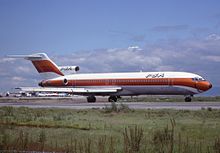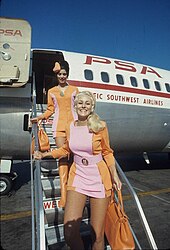Pacific Southwest Airlines
[2] The Los Angeles Times called PSA "practically the unofficial flag carrier airline of California for almost forty years.
When GI business dried up, on May 6, 1949, Friedkin started flying once a week from San Diego to Oakland via Burbank with a $1,000-a-month leased Douglas DC-3.
But CCA was not as focused as PSA (which stuck just to the San Diego to Bay Area route) and ultimately went bankrupt.
About half of these flights by the competition were First Class only ($22.05); the rest carried coach passengers for $13.50, all fares subject to then 5% federal excise tax.
[16] In July 1958 PSA shifted some flights from Burbank to Los Angeles International Airport (LAX); that year it carried 296,000 passengers.
This was the era of hot-pant clad flight attendants on pink-liveried aircraft, a classic image of California in the late 1960s and early 1970s.
[22] Prospectus facts that caught the eye of one observer included:[23] Until 1965, as an intrastate airline PSA had a free hand in terms of how and where it flew within California.
As of September 17, 1965, the CPUC had new powers over California intrastate airlines of economic certification (PSA was grandfathered) route entry/exit and service quality (e.g.
PSA believed it would benefit from market stability,[28] but observers predicted that over time the CPUC would become just as restrictive as the CAB,[29] which, in fact, happened.
[51] One of PSA's first actions of the deregulated era (which started January 1, 1979) was to exit Tahoe, citing the high cost of Electras in a fleet that otherwise comprised 31 727s.
[54] An early indication that, for J. Floyd Andrews, PSA was not enough came in December 1968 with an audacious bid for Western Air Lines, then under attack by Kirk Kerkorian.
Founding president Lamar Muse was open about the debt to PSA, saying "we don't mind being copycats of an operation like that", including hotpants.
[58] PSA helping Southwest made sense in 1971, with each airline strictly limited to flying within its state and seemingly no prospect of that ever changing.
[65] In June 1971, PSA committed to a to-be constructed hotel at the Los Angeles Hollywood Park Racetrack (now the site of SoFi Stadium),[66] and in December 1971, committed to a to-be constructed hotel within the Queen Mary attraction in Long Beach[67] The synergies were not obvious.
[89] As the regulated era drew to a close, PSA suffered a terrible crash in September 1978 when a 727 collided with a small plane over San Diego, fatal to all on both aircraft and to some on the ground.
[97] But in December 1978, Paul Barkley, then PSA’s chief operating officer (later CEO), spoke about the deregulated future a few weeks away.
He expected something fairly sedate, quite different from the bitter Darwinistic struggle that would engulf the industry:[98] Dallas-Fort Worth–based Braniff International Airways was the first trunk carrier to fail after deregulation.
[110] In October 1982, PSA announced a cheap and low-risk deal to expand into a new geography: under an eight year contract, Braniff would fly 25 to 30 727s from its Texas base with PSA colors and marketing, employing 1,500 Braniff employees (who would have to agree to lower wages and higher productivity) as well as gates and takeoff/landing slots.
[115] A second iteration of Braniff did start flying in 1984 without PSA help, ultimately without success, possible due to Texas already being home to Southwest (which, expanding westward, had already entered PSA’s home city of San Diego in January 1982),[116] American Airlines (which viewed Dallas-Fort Worth as its own, having moved its headquarters there in 1979)[117] and Continental Airlines, which in 1983 would go through a bankruptcy that dramatically lowered its costs.
As the nearby table shows, AirCal’s nominal growth from 1978 (the last year of regulation) to 1985 was double that of PSA, Southwest was nearly triple.
A July 1984 Los Angeles Times article noted PSA had been hanging fire since deregulation; management always waiting for some obstacle to clear.
Note, "airline profits", not the holding company, PSA, Inc., which included aircraft leasing and fuel distribution among other businesses.
[134] 1986 was the year of the airline merger – Republic into Northwest, Ozark into TWA, Western into Delta Air Lines and others.
[135] The combination had its skeptics: USAir’s pre-PSA California presence was 12 flights per day to Pittsburgh and Indianapolis so its brand awareness among Californians was minimal.
[139] By the time the merger was consummated, PS Group had used some the PSA money to buy a stake in a travel agency business, to go along with its aircraft leasing and oil & gas interests.
State legislators were increasingly irate, finally proposing a raft of bills to punish the carriers, even suggesting a state-owned airline,[141] but the market had already taken care of the problem.
In January 1991, in announcements only two weeks apart, first American and then USAir gutted the former AirCal and PSA systems, throwing in the towel less than five years after offering to buy the former intrastate airlines.
[146] Because of the major San Diego flight schedule and its discount fares, military personnel nicknamed PSA the "Poor Sailor's Airline.
[145] A PSA flight attendant, Marilyn Tritt, wrote a book about her tenure at the company titled Long Legs and Short Nights.
The following are notable hijackings because of fatalities or because the aircraft flew to another country: PSA served the following domestic destinations in the U.S. at various times during its existence.









